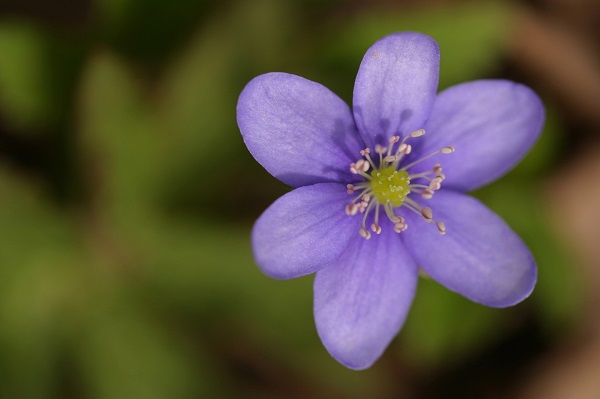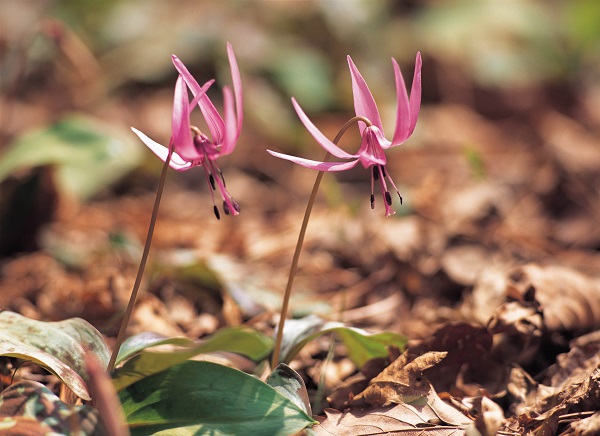Once again, the spring ephemerals are carpeting the forest and woodland floor only to be quickly admired and sleep again until next year. Spring ephemerals (i fem’ ur als) are plants whose glory lasts only a few days but the memory of their beauty will remain with you for months come.
You will find yourself looking expectantly for their return the following spring. These native wonders emerge before the trees leaf out as they must acquire enough sunlight to produce seed and store energy before the forest canopy fills in. Then they fade away until next year. They aren’t here for long so enjoy the fleeting beauty of spring’s earliest wonders.

Hepatica americana, Liverleaf, is one of the earliest harbingers of spring. It bears dainty 1/2” white flowers blushed with pink or deep blue. The flowers are born on stalks which leap into view directly from the plant’s center. You will find fine hairs growing along the stalks. The leaf cycle is interesting as before the new leaves unfurl, the blossoms are often bursting into bloom. The leathery leaves will then open to bask in the sunlight. Once established, the Liverleaf will blanket a woodland floor. You will need to look carefully to admire its beauty; however, as this miniature plant never reaches more than six inches tall.
The Trout Lily or Dogtooth Violet, Erythronium americanu are said to acquire their name from the speckled leaves which are reminiscent of the speckled skin of a trout. It generally grows in colonies of dozens to hundreds of plants and will spread prolifically on underground runners. Small yellow to brownish flowers may be hidden beneath the leaf litter on the woods floor or may be too pale to be easily noticed. Once you recognize the leaf pattern, there will be little doubt as to the plant’s identity. Found frequently near streams, rich woods, or on wooded slopes, Erythronium americanum will bloom from March to May on four to ten-inch plants that sport the often pale-colored one inch flowers.

The exceptionally flashy Jack-in-the-Pulpit is found in moist woodlands. Its coloration varies with deep purple, red, brown or white stripes on its slender green spathe. Also known as Arisaema triphyllum, Jack-in-the-Pulpit displays its unusual hooded “pulpit” on tall stems. Standing one to three feet, it exhibits only two or three leaves with each leaf consisting of three glossy green leaflets, hence the triphyllum portion of it name, tri meaning three and phyllum meaning leaf. This is one woodland native that boldly announces its presence. After fertilizing, clusters of red berries appear under the wilted spathe and provide food for passing wildlife.
You might be tempted to bring some of these plants home with you, but it is not a good idea. Many ephemerals are protected by the Endangered Species Act. Others are sheltered in various states by their own Department of Natural Resources. Also, most wild plants do not transplant well. They are growing in conditions that are often difficult to duplicate in the home garden.
Native mycorrhizal fungi exist in natural habitats. These fungi are critical to successful growth of many ephemerals and wildflowers. This article gives a good explanation of how mycorrhizae and other beneficial microorganisms help the soil and plants. Commercial propagation makes many of these plants available for you to purchase at garden centers or nurseries without damage to them in their native habitat. Be responsible! Purchase your plants from nursery-propagated stock from reputable, licensed mail order catalogues or at specialized nurseries.
Stay alert on your next outdoor excursion and you will surely find one of these beauties. Once you recognize them for what they are, ephemerals will captivate you. Have fun and choose from any number of outstanding native ephemerals that are available commercially.
Marlene Gillman is the owner of Gardensgreen. You can visit her website at GardensGreen.com.
Related Articles & Free Email Newsletter Sign Up
How to Care For an Indoor Ficus benjamina
Plant Profile – Crimson Pygmy Barberry is a Great, Low Maintenance Landscape Plant
Plant Profile – Iris Blue Flag Fits Nicely into a Low Maintenance Landscaping Plan




Comment here